| Acervo Artistico e Cultural do Palacio dos Bandeirantes - MAP 6
Palácio dos Bandeirantes is the seat of the government of São Paulo and the governor’s official residence.
Architecture
The first architectural concept for Palácio dos Bandeirantes was conceived by Italian architect Marcello Piacentini, in 1938. He was commisioned by Count Francisco Matarazzo’s nephew and the construction was meant to house Count Francesco Matarazzo School of Commer... |
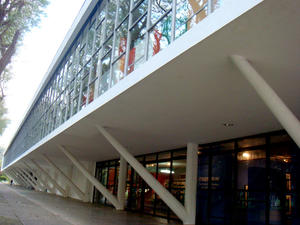 Afro Brasileiro Museum - MAP 3
The Museu Afro Brazil is a public institution, subordinated to the Ministry of Culture of São Paulo Association and administered by the Museu Afro Brazil - Social Organization of Culture.
The Museum maintains a collection of more than 5,000 works, including paintings, sculptures, prints, photographs, documents and ethnological of Brazilian and foreign authors, produced between the fifteenth century... Afro Brasileiro Museum - MAP 3
The Museu Afro Brazil is a public institution, subordinated to the Ministry of Culture of São Paulo Association and administered by the Museu Afro Brazil - Social Organization of Culture.
The Museum maintains a collection of more than 5,000 works, including paintings, sculptures, prints, photographs, documents and ethnological of Brazilian and foreign authors, produced between the fifteenth century... |
| Arqueologia e Etnologia da USP Museum - MAP 3 MAE / USP is a University Museum that has under its custody a rich collection of Archaeology and Ethnology. Its teachers and students develop cutting-edge research in these two areas and also in Museology. Because it is a University Museum, the MAE also operates with the popularization of science through exhibitions and other educational activities.
The collection of the MAE is composed of more than 100,000 specimens, including arc... |
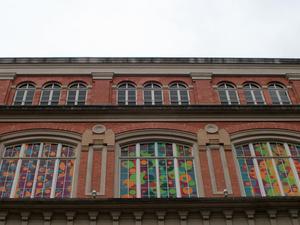 Arquivo do Estado - MAP 3
In the district of Santana are stored relics that tell the history of São Paulo. The Public Archives of the State of São Paulo is one of the oldest institutions of São Paulo. There you can find documents related to the basements of the military dictatorship, which belonged to the former state Department of Social Policy Order (DEOPS) and private collections of former governors and presidents, such as Julio Pre... Arquivo do Estado - MAP 3
In the district of Santana are stored relics that tell the history of São Paulo. The Public Archives of the State of São Paulo is one of the oldest institutions of São Paulo. There you can find documents related to the basements of the military dictatorship, which belonged to the former state Department of Social Policy Order (DEOPS) and private collections of former governors and presidents, such as Julio Pre... |
| Arte Brasileira Museum - MAP 3
The MAB - Museu de Arte Brasileira (FAAP) collection brings together some of the MAB 3,000 works of Brazilian and foreign artists settled here. It covers some colonial productions, such as a gilded altar and names are representative of pre-modernism as Pedro Alexandrino and Belmiro de Almeida. Brings together a rich pool of artists linked to Modernism as is the case of Emiliano Di Cavalcanti, Tarsila do Amaral, Victor Brecheret, Isma... |
| Arte Contemporânea Universidade de São Paulo Museum - MAP 3
The Museum of Contemporary Art of São Paulo is one of the most important museums of modern and contemporary art from Latin America. The collection has around ten thousand works - including including oil paintings, drawings, prints, photographs, sculptures, objects and works of conceptual art and contemporary art by artists such as Picasso, Matisse, Miró, Kandinsky, Modigliani, Calder, Braque, Henry Moore, Tarsila do Ama... |
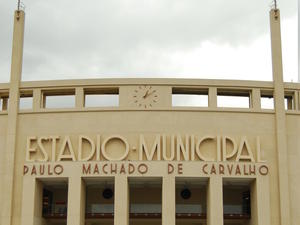 Arte do Futebol Museum - MAP 6
The Museu da Arte do Futebol (Soccer Museum) location could not be more appropriate: it is under the stands at Pacaembu Stadium, the most beautiful of the city. To tell the history of Brazilian football, the curators turned to interactive audiovisual resources to the detriment of relics and collectibles.
At the entrance, pictures of stars like Pele, Zico and Ronaldo are projected on large screens hung from ... Arte do Futebol Museum - MAP 6
The Museu da Arte do Futebol (Soccer Museum) location could not be more appropriate: it is under the stands at Pacaembu Stadium, the most beautiful of the city. To tell the history of Brazilian football, the curators turned to interactive audiovisual resources to the detriment of relics and collectibles.
At the entrance, pictures of stars like Pele, Zico and Ronaldo are projected on large screens hung from ... |
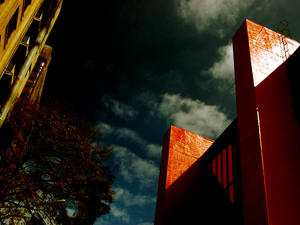 Arte Moderna de Sao Paulo Museum - MAP 3 The Museum of Modern Art of São Paulo MAM is a public interest civil society, non-profit, and is one of the most important museums in Latin America.
They are part of his collection more than 5000 works, bringing together over one thousand artists among the most expressive of modern and contemporary art in Brazil.
The MAM maintains an annual schedule of major exhibitions and promotes every two years, the panorama of Brazilian art, one... Arte Moderna de Sao Paulo Museum - MAP 3 The Museum of Modern Art of São Paulo MAM is a public interest civil society, non-profit, and is one of the most important museums in Latin America.
They are part of his collection more than 5000 works, bringing together over one thousand artists among the most expressive of modern and contemporary art in Brazil.
The MAM maintains an annual schedule of major exhibitions and promotes every two years, the panorama of Brazilian art, one... |
| Arte Sacra de Sao Paulo Museum - MAP Museu da Arte Sacra de Sao Paulo
Avenida Tiradentes 676
Bairro da Luz
Tel 3326-1373
http://artesacra.sarasa.com.br/
|
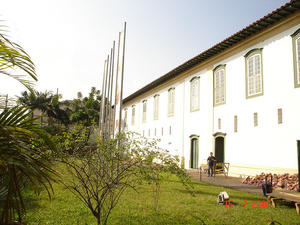 Arte Sacra de São Paulo Museum - MAP (Art Sacred Museum of São Paulo)The Museum of Sacred Art of Sao Paulo works in what was once a monastery, The Monastery of Light, which was founded and built by Friar Antonio de Sant'Anna Galvao, in 1774 and is currently considered one of the most important architectural monuments colonial eighteenth-century Sao Paulo. Closed on the last farm urban convent in light district, the heart of the city of Sao Paulo, was listed by the Nationa... Arte Sacra de São Paulo Museum - MAP (Art Sacred Museum of São Paulo)The Museum of Sacred Art of Sao Paulo works in what was once a monastery, The Monastery of Light, which was founded and built by Friar Antonio de Sant'Anna Galvao, in 1774 and is currently considered one of the most important architectural monuments colonial eighteenth-century Sao Paulo. Closed on the last farm urban convent in light district, the heart of the city of Sao Paulo, was listed by the Nationa... |
| Automovel de Sao Paulo Museum - MAP 3 An old idea from someone who was passionate about car since his childhood became reality in September 21, 1999, when the São Paulo Auto Museum was inaugurated. Romeo Siciliano (who died in April 2008) started collecting cars in his house and when he realized he had enough to establish a museum.
Visitors enjoy the rarities ranging from vintage cars to motorcycles, scooters, scooters, tricycles, trucks, can also know the history and e... |
| Banespa Sandander Museum - MAP 3 Better known as Banespa building, the Altino Arantes is famous for its 360-degree lookout at the top of the building, offering visitors a panoramic view of the city.
During 20 years was the tallest building in Sao Paulo, and in 1948 considered the largest concrete structure in the world. It has 35 floors, 161 meters, 900 degrees. And calm down! We lift up!
In addition to the observatory, the building has a lobby that houses exhibi... |
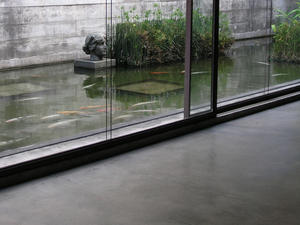 Brasileiro de Escultura Museum - MAP 3
The MuBE - Brazilian Sculpture Museum is a private institution of public interest, created to promote art in its various segments, sculpture, painting, photography, graffiti, drawing, music, cinema. Located in Sao Paulo, home to an extensive schedule, with special attention to the sculptural production in Brazil.
The museum receives annually from 80 to 100 thousand people to see its collection, visit its exhibitions, p... Brasileiro de Escultura Museum - MAP 3
The MuBE - Brazilian Sculpture Museum is a private institution of public interest, created to promote art in its various segments, sculpture, painting, photography, graffiti, drawing, music, cinema. Located in Sao Paulo, home to an extensive schedule, with special attention to the sculptural production in Brazil.
The museum receives annually from 80 to 100 thousand people to see its collection, visit its exhibitions, p... |
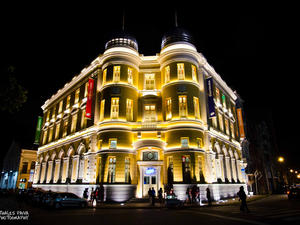 Caixa Economica Federal Museum - MAP
Who passes through Cathedral Square always has an eye toward an imposing building whose facade boasts black granite Ionic colonnade surmounted by imposing too sober and classic pediment. The building is where the agency operates the Federal Savings Bank.
For a long time the place was the seat of the presidency of the box. With unification in 1971, it housed the headquarters of the São Paulo branch, until in 1979... Caixa Economica Federal Museum - MAP
Who passes through Cathedral Square always has an eye toward an imposing building whose facade boasts black granite Ionic colonnade surmounted by imposing too sober and classic pediment. The building is where the agency operates the Federal Savings Bank.
For a long time the place was the seat of the presidency of the box. With unification in 1971, it housed the headquarters of the São Paulo branch, until in 1979... |
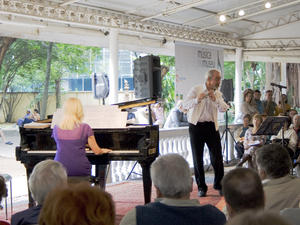 Casa Brasileira Museum - MAP Created in May 1970 under the name Museum of Art and Furniture History of Brazil, in1971 changed its name to the Brazilian House. Its main objective is the formation of aresearch center on equipment and customs of Brazilian houses, with permanent exhibition of its collection.
The Brazilian House Museum (MCB), a prime location for easy access in the city of São Paulo (Avenida Brigadeiro Faria Lima, 2705), seeks to fulfill this task. ... Casa Brasileira Museum - MAP Created in May 1970 under the name Museum of Art and Furniture History of Brazil, in1971 changed its name to the Brazilian House. Its main objective is the formation of aresearch center on equipment and customs of Brazilian houses, with permanent exhibition of its collection.
The Brazilian House Museum (MCB), a prime location for easy access in the city of São Paulo (Avenida Brigadeiro Faria Lima, 2705), seeks to fulfill this task. ... |
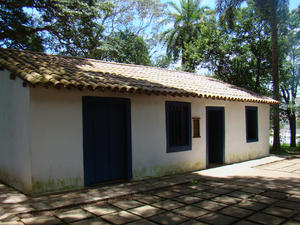 Casa do Grito - MAP 3
The Museum of the City of São Paulo is organized through a network of twelve historic buildings and areas administered by the Department of Historic (DPH).
Created in 1993, its conceptualization and implementation have been made gradually over successive governments. The conceptual and administrative core of the network lies in the combination of the Solar da Marquesa de Santos, Pinto Alley (... Casa do Grito - MAP 3
The Museum of the City of São Paulo is organized through a network of twelve historic buildings and areas administered by the Department of Historic (DPH).
Created in 1993, its conceptualization and implementation have been made gradually over successive governments. The conceptual and administrative core of the network lies in the combination of the Solar da Marquesa de Santos, Pinto Alley (... |
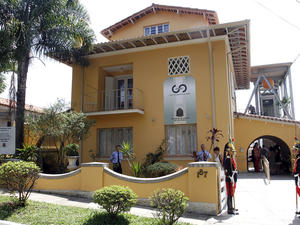 Casa Guilherme de Almeida - MAP 3
Opened in March 1979, houses a significant collection consisting of objects that belonged to the poet, translator, journalist and lawyer Paulo Guilherme de Almeida (1890-1969), one of the masterminds of the Brazilian modernist movement.
The museum is housed in the residence where he lived from 1946 until the year of his death. The House of Paulo Guilherme de Almeida - whose main objective is to promote knowledge of the... Casa Guilherme de Almeida - MAP 3
Opened in March 1979, houses a significant collection consisting of objects that belonged to the poet, translator, journalist and lawyer Paulo Guilherme de Almeida (1890-1969), one of the masterminds of the Brazilian modernist movement.
The museum is housed in the residence where he lived from 1946 until the year of his death. The House of Paulo Guilherme de Almeida - whose main objective is to promote knowledge of the... |
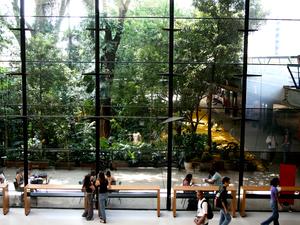 Centro Cultural Sao Paulo - MAP 3
Initially designed to house an extension of Mário de Andrade Library, Centro Cultural São Paulo suffered in the course of its construction, a series of changes to become one of the first multidisciplinary cultural venues in the country.
Opened in 1982, offers theater, dance and music, visual arts exhibitions, film and video projections, workshops, debates and courses, and maintains significant collections... Centro Cultural Sao Paulo - MAP 3
Initially designed to house an extension of Mário de Andrade Library, Centro Cultural São Paulo suffered in the course of its construction, a series of changes to become one of the first multidisciplinary cultural venues in the country.
Opened in 1982, offers theater, dance and music, visual arts exhibitions, film and video projections, workshops, debates and courses, and maintains significant collections... |
| Cidade de Sao Paulo Museum - MAP 3
The Museum of the City of São Paulo is organized through a network of twelve historic buildings and areas administered by the Department of Historic (DPH).
Created in 1993, its conceptualization and implementation have been made gradually over successive governments. The conceptual and administrative core of the network lies in the combination of the Solar da Marquesa de Santos, Pinto Alley (... |
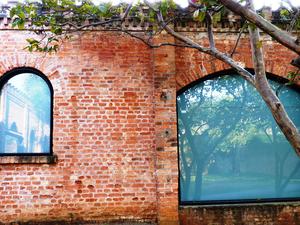 Cinemateca Brasileira - MAP 3
The Brazilian Cinema emerged from the creation of the Film Club of São Paulo in 1940. Its founders were young students of the Philosophy of the USP, including, Paulo Emilio Salles Gomes, Decio de Almeida Prado and Antonio Candido de Mello e Souza. The Club was closed by the police during the Estado Novo.
Its historic buildings, opened in the nineteenth century, were listed by Condephaat - Council of Defens... Cinemateca Brasileira - MAP 3
The Brazilian Cinema emerged from the creation of the Film Club of São Paulo in 1940. Its founders were young students of the Philosophy of the USP, including, Paulo Emilio Salles Gomes, Decio de Almeida Prado and Antonio Candido de Mello e Souza. The Club was closed by the police during the Estado Novo.
Its historic buildings, opened in the nineteenth century, were listed by Condephaat - Council of Defens... |
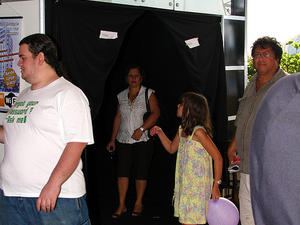 Computador Museum - MAP 3
The Computer Museum is more than 12 years making the preservation of the history of the world's computers.
The collection includes over 10,000 pieces ranging from abacus to the modern computers. Behind every piece there is a history and you will find beyond the history of each machine also its inventors who made history with his inventions.
Address: Avenida Rio Bonito 1201
Bairro do Socorro
... Computador Museum - MAP 3
The Computer Museum is more than 12 years making the preservation of the history of the world's computers.
The collection includes over 10,000 pieces ranging from abacus to the modern computers. Behind every piece there is a history and you will find beyond the history of each machine also its inventors who made history with his inventions.
Address: Avenida Rio Bonito 1201
Bairro do Socorro
... |
| Contemporaneo das Invencoes Museum - MAP 3
Some of the curious inventions that comprise the collection of the Museum of Contemporary Inventions, are a cardboard chair, a card shower, Kangaroo bicycle, foldable dog house, popcorn machine, goggles for eye drops and comfortable shoes. A different museum where visitors can check out the creativity of human beings.
Unique in Latin America, the museum combines fun and culture, housing nearly 400 products, with many d... |
| Crime - Policia Civil Museum - MAP 3
The 600 square meters of the institution keep photos, documents, weapons, drugs, gambling machines, furniture and instruments used by police in past decades.
The site also houses weapons used in crimes - knives, guns, rifles, machine guns - unusual objects made by criminals, as solder used to produce cage that served as a captive. Other highlights: tattoos in jail, pictures of homicides and suicides and crimes simulati... |
| Educacao e do Brinquedo Museum - MAP 3
The Museum of Education and Toy, created at the Faculty of Education, University of São Paulo, is a space for visitation and research that aims to help individual development through the analysis of the universe play involving toys and the very act of playing.
The site offers explanatory visits for educators who subsequently monitor their students in the analysis of the exhibits. There are also workshops and res... |
| Energia de Sao Paulo Museum - MAP 6
The Energy Museum of São Paulo is located in the suburb of Champs Elysees, near the Luz and Bom Retiro in place of outstanding historical and cultural importance to the city of São Paulo.
In operation since 2005, this is an open space for knowledge and discussion of the history of energy technology development in the energy sector and its impacts, and present topics on industrialization and urbanization o... |
| Energia Museum - MAP Museu da Energia
Rua do lavapes 463
Bairro do Cambuci
Tel 3276-4747 |
| Estação Pinacoteca - MAP 3 Built in 1914, the building currently occupied by the Pinacoteca Station was designed to house offices and warehouses of the Railroad Sorocabana which, with its 108 km long, interconnected Sao Paulo Sorocaba. With the completion in 1938, new facilities of the railroad company, the building designed by architect Ramos de Azevedo, was made available to the State. After reforms, the building, housed the State Department of Social and Polit... |
| Folclore Rossini Tavares de Lima Museum - MAP 3
With the departure of the Center for Indian Culture in 1993, the house has undergone restoration and conservation work being occupied by the Museum of Folklore "Rossini Tavares de Lima" in 2000.
The construction of the house of Caxingui, according to studies by the architect Luis Exit was in mid-seventeenth century. Its architecture into three sections, hipped roof and walls, rammed earth is quite characteris... |
| Fundacao Maria Luisa e Oscar Americano - MAP 3
The Maria Luisa and Oscar Americano Foundation was established by Oscar Americano in March 1974, two years after the death of Maria Luisa Ferraz Americano, donating to the city of São Paulo, the house where their children lived for 20 years as well as a collection of works of art and an extensive park.
Preserving nature, gathering papers and documents connected with the history of Brazil, doing courses, co... |
| Fundacao Museu da Tecnologia de Sao Paulo - MAP 3
The Centre of Contemporary Technology - CAT, Technology Museum Foundation of São Paulo is a large space with modern facilities. Its aim is to preserve the heritage of technology, historical and cultural education and culture to enable the society, the technological understanding of the phenomenon and its rapid and constant change, showing the path of technology in different segments. To meet its goal restores and mai... |
| Geologico Valdemar Lefevre Museum - MAP 3
The MUGEO was created on November 14, 1967, but part of its collection originated in the Geographic and Geological Commission - CGG (1886-1931). The permanent exhibitions of the Museum are, basically, minerals, rocks, fossils, old objects and documents gathered from the work of the Geographical and Geological Commission of São Paulo, from the last century.
The Museum is not only a center display collection, it r... |
| Historico da Imigracao Japonesa no Brasil Museum - MAP 3
The Historical Museum of Japanese Immigration in Brazil was inaugurated on June 18, 1978, created the great achievement of the 70th. anniversary of Japanese immigration to Brazil. The opening ceremony was attended by the then Crown Prince Akihito of Japan and by President Ernesto Geisel.
The goal of the Brazilian Society of Japanese Culture - Bunkyo, responsible for the initiative was to record and preserve all he coul... |
| Imagem e do Som de Sao Paulo Museum - MAP 3
The Museu da Imagem e do Som - MIS has more than 200 000 items. Are photographs, films, videos, posters, records and sound recordings. The collection offers a Media Library with copies of broadcast and publications for consultation, research rooms and Internet connection open to the public, including on weekends and holidays. In the MIS Media Library you can consult copies of some of the collections that make up the museum'... |
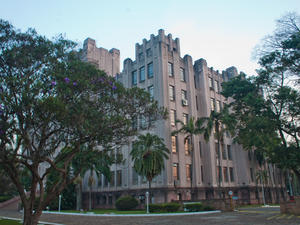 Instituto Biologico Museum - MAP 3
The collection of the Biological Institute began in 1927. Initially, the scientific activities of the institution were held in rented houses and Arthur Neiva, the first director, housed a library in a location at Luis Antonio Ave. that, in addition to magazines and books on coffee pests, the creation of the IB paradigm, other books and texts were being added.
Henrique da Rocha Lima, José Reis and... Instituto Biologico Museum - MAP 3
The collection of the Biological Institute began in 1927. Initially, the scientific activities of the institution were held in rented houses and Arthur Neiva, the first director, housed a library in a location at Luis Antonio Ave. that, in addition to magazines and books on coffee pests, the creation of the IB paradigm, other books and texts were being added.
Henrique da Rocha Lima, José Reis and... |
| Instituto Butantan - MAP 3
The Butantan Institute, linked to the Ministry of Health of São Paulo, is one of the largest biomedical research centers in the world, accounting for more than 93% of serums and vaccines produced in Brazil, among them diphtheria, tetanus , pertussis, hepatitis B and influenza seasonal and H1N1.
The Institute conducts basic research and studies in Biology and Biomedicine, related directly or indirectly, to public... |
| Instituto de Botanica - MAP 3
The Institute of Botany is a public organization of the State of Sao Paulo linked to the Department of the Environment.
Conducts research and studies on plants, fungi and cyanobacteria in order to conserve and protect Brazil's biodiversity, provide scientific information for the management of natural resources and raise awareness about the importance of natural resources.
Manages 15 specialized la... |
| Instituto de Patrimonio Historico e Artistico Nacional Museu Lasar Segall - MAP 6
Conceived by Jenny Klabin Segall, the artist’s widow, the Museum was created by their sons Mauricio Segall and Oscar Klabin Segall in 1967. It is installed in the artist’s former residence and studio, designed in 1932 by his brother-in-law, the Russian-born architect Gregori Warchavchik.
The collection comprises over three thousand items. There are 32 oil paintings (on canvas, cardboard and paper), 54 paint... |
| Itau Numismatica - MAP 8
The Herculano Pires Museum of Itaú Numismática is one of a kind and it is structured to receive both specialized public and general public, offering the needed information to all sorts of cultural interests and age groups.
The visits can be individual or monitored; in this case groups of 10 to 20 people, previously set up, in Portuguese or English.
The presentation begins with an informative video, calling to the attentio... |
| Liceu de Artes e Oficios de Sao Paulo - MAP 3
The School of Arts and Letters of São Paulo is a private non-profit organization that offer 105 vacancies annually integrated technical education to high school with total generosity in the areas of electronics with an emphasis on Programmable Digital Systems, Buildings and Multimedia.
In addition to the Integrated Technical Education, the School also offers the School Regular Pay. Created in 1873 The... |
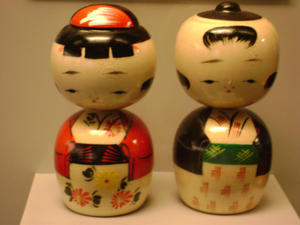 Lingua Portuguesa Museum - MAP 6
The Portuguese Language Museum is the meeting point with the visitor's language, literature and history displayed through visual aids and technology. Instead of walls, voices. In place of works, interactive spaces. In the heart of São Paulo in the Light Station, the Museum provides a sensory journey through the Portuguese language and subjective, the sixth most spoken language in the world, guided by words, writers and sta... Lingua Portuguesa Museum - MAP 6
The Portuguese Language Museum is the meeting point with the visitor's language, literature and history displayed through visual aids and technology. Instead of walls, voices. In place of works, interactive spaces. In the heart of São Paulo in the Light Station, the Museum provides a sensory journey through the Portuguese language and subjective, the sixth most spoken language in the world, guided by words, writers and sta... |
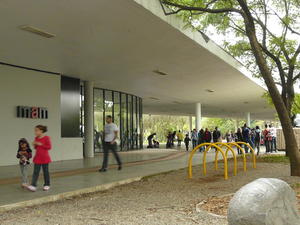 Mam - Museu de Arte Moderna de São Paulo - MAP 3
The Museum of Modern Art in São Paulo - MAM is a public interest civil society, non-profit, and is one of the most important museums in Latin America. Its misson is to collect, study, promote and disseminate modern and contemporary art in Brazil, making it accessible to as many people as possible.
Part of its collection over 5000 works, bringing together more than a thousand artists among the most expressi... Mam - Museu de Arte Moderna de São Paulo - MAP 3
The Museum of Modern Art in São Paulo - MAM is a public interest civil society, non-profit, and is one of the most important museums in Latin America. Its misson is to collect, study, promote and disseminate modern and contemporary art in Brazil, making it accessible to as many people as possible.
Part of its collection over 5000 works, bringing together more than a thousand artists among the most expressi... |
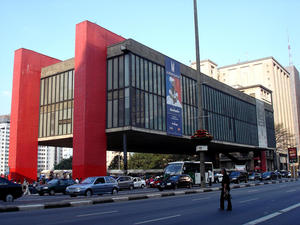 MASP - Museu de Arte de São Paulo - MAP MASP is the most important museum of western art in the Southern Hemisphere
Its collection is listed by the Historical and Artistic Heritage - IPHAN since 1969 and currently has about 8,000 pieces, among which stand out Western paintings, mainly Italian and French. Thirteenth century to today, you can enjoy Raphael, Mantegna and Botticceli - the Italian school - and Delacroix, Renoir, Monet, Cézanne, Picasso, Modigliani, Toulouse-L... MASP - Museu de Arte de São Paulo - MAP MASP is the most important museum of western art in the Southern Hemisphere
Its collection is listed by the Historical and Artistic Heritage - IPHAN since 1969 and currently has about 8,000 pieces, among which stand out Western paintings, mainly Italian and French. Thirteenth century to today, you can enjoy Raphael, Mantegna and Botticceli - the Italian school - and Delacroix, Renoir, Monet, Cézanne, Picasso, Modigliani, Toulouse-L... |
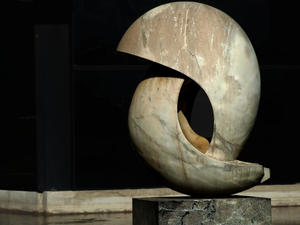 Memorial da America Latina - MAP Memorial da America Latina
Avenida Auro Soares de Moura Andrade 664
Bairro da Barra Funda
Tel 3823-4600
http://www.memorial.sp.gov.br/memorial/index.jsp Memorial da America Latina - MAP Memorial da America Latina
Avenida Auro Soares de Moura Andrade 664
Bairro da Barra Funda
Tel 3823-4600
http://www.memorial.sp.gov.br/memorial/index.jsp
|
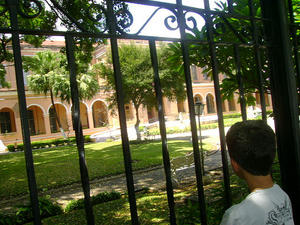 Memorial do Imigrante - MAP 6 Consolidated as a plural city, home to several nationalities, São Paulo has become, since 1870, the fate of many immigrants fleeing political and economic upheaval in their countries of origin - especially in Europe. The work on coffee farms has attracted many foreigners in search of a better life. To get them opened in the late nineteenth century, an inn in the neighborhood of Brás. The immigrants landed at the port of Santos and wer... Memorial do Imigrante - MAP 6 Consolidated as a plural city, home to several nationalities, São Paulo has become, since 1870, the fate of many immigrants fleeing political and economic upheaval in their countries of origin - especially in Europe. The work on coffee farms has attracted many foreigners in search of a better life. To get them opened in the late nineteenth century, an inn in the neighborhood of Brás. The immigrants landed at the port of Santos and wer... |
| Memorias do Bexiga Museum - MAP Museu Memorias do Bexiga
Rua dos Ingleses 118
Bairro da Bela Vista
Tel 3285-5009 |
| Monteiro Lobato Museum - MAP Museu Monteiro Lobato
Rua General Jardim 485
Bairro da Vila Buarque
http://www.museumonteirolobato.com.br/
|
| Museo da Geociencias - MAP Museo da Geociencias
Rua do Lago 562
Bairro do Butanta
Tel 3091-3952
http://www2.igc.usp.br/museu/
|
| Oculos Giocondo Giannini Museum - MAP Museu de Oculos Giocondo Giannini
Rua dos Ingleses 108
Bairro Bela Vista
Tel 3253-2000 |
| Paco das Artes - MAP Paco das Artes
Avenida Universidade 1
Bairro do Butanta
Tel 3229-9844
http://www.pacodasartes.org.br/
|
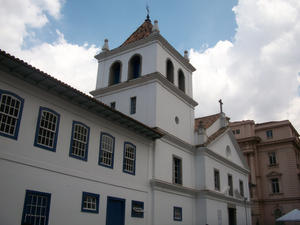 Padre Anchieta Museum - MAP 3
Made up from donations and the return of some of the objects that originally belonged to the Church and the Jesuit College, the current collection of the museum is almost entirely exposed, without compliance with the criteria essential to their real characterization and subsequent recovery. The recent lementação museum and museological project allowed the objects that constitute the acquis could be identified, sorted, o... Padre Anchieta Museum - MAP 3
Made up from donations and the return of some of the objects that originally belonged to the Church and the Jesuit College, the current collection of the museum is almost entirely exposed, without compliance with the criteria essential to their real characterization and subsequent recovery. The recent lementação museum and museological project allowed the objects that constitute the acquis could be identified, sorted, o... |
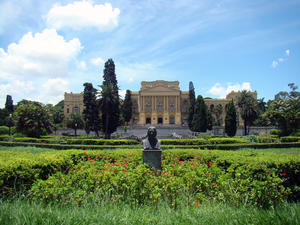 Paulista Museum - MAP
Museu Paulista ( Museu do Ipiranga )
Parque da Independecia S/N
Bairro do Ipiranga
Tel 6165-8000
http://www.mp.usp.br/ Paulista Museum - MAP
Museu Paulista ( Museu do Ipiranga )
Parque da Independecia S/N
Bairro do Ipiranga
Tel 6165-8000
http://www.mp.usp.br/
|
| Pessoa Museum - MAP Museu da Pessoa
Rua Delfina 342
Bairro Vila Madalena
Tel 3814-4912
http://www.museudapessoa.net/
|
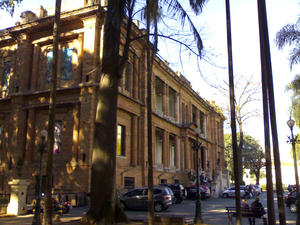 Pinacoteca do Estado - MAP 3
The Pinacoteca do Estado de Sao Paulo Museum of Art is the city's oldest and certainly one of the most important country. Born in the building originally built to house the School of Arts and Crafts in St. Paul. Therefore, the history of Pinacoteca confused in its infancy with the deployment of Lyceum, and their presence in the building - troubled by a series of historical events, such as conflicts of 1930 and 1932, and refo... Pinacoteca do Estado - MAP 3
The Pinacoteca do Estado de Sao Paulo Museum of Art is the city's oldest and certainly one of the most important country. Born in the building originally built to house the School of Arts and Crafts in St. Paul. Therefore, the history of Pinacoteca confused in its infancy with the deployment of Lyceum, and their presence in the building - troubled by a series of historical events, such as conflicts of 1930 and 1932, and refo... |
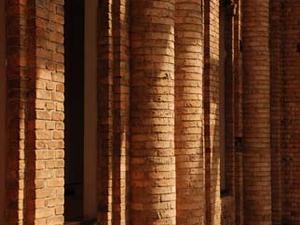 Pinacoteca do Estado de São Paulo - MAP The Pinacoteca do Estado de Sao Paulo art museum is the city's oldest and certainly one of the most important country. Born in the building originally built to house the School of Arts and Crafts in St. Paul. Therefore, the history of Pinacoteca confused in its infancy with the deployment of Lyceum, and his presence in the building - troubled by a series of historical events, such as conflicts of 1930 and 1932, and reforms - alternated ... Pinacoteca do Estado de São Paulo - MAP The Pinacoteca do Estado de Sao Paulo art museum is the city's oldest and certainly one of the most important country. Born in the building originally built to house the School of Arts and Crafts in St. Paul. Therefore, the history of Pinacoteca confused in its infancy with the deployment of Lyceum, and his presence in the building - troubled by a series of historical events, such as conflicts of 1930 and 1932, and reforms - alternated ... |
| Policia Militar Museum - MAP Museu da Policia Militar
Rua Jorge Miranda 308
Bairro da Luz
Tel 3227-3793 |
| Relogio Museum - MAP Museu do Relogio
Avenida Mofarrej 840
Bairro Vila Leopoldina
Tel 3646-4000 |
| Santa Casa de Misericordia Museum - MAP 6
The Museum of Santa Casa de Misericordia de São Paulo was founded in June 2000 with the intention of gathering the collection of part of the history of more than 400 years of the Brotherhood of Santa Casa.
It has a cultural heritage with paintings, furniture, photographs, certificates and diplomas, sculptures, plaques and medals and rooms devoted to medicine, medical apparatus and instruments.
The... |
| Saude Publica Emilio Ribas Museum - MAP 6
The Public Health Museum Emilio Ribas was installed in 1979 in the old building of the Central Desinfectório, built in 1893, the site of the former headquarters of the ranch Bom Retiro. Protected by Condephaat in 1984, is considered an architectural heritage of historic importance to the State of São Paulo.
Since its inception, has been dedicated as a depositary of the most important documentary collectio... |
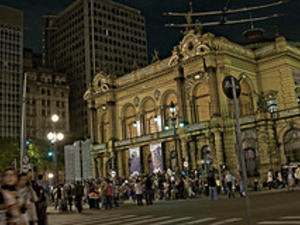 Teatro Municipal de Sao Paulo Museum - MAP 3
Inaugurated on October 11, 1983, the Museum of the Municipal Theater of São Paulo intended to collect and preserve objects, documents, records and reports pertaining to the history of the theater.
The Museum keeps the history of the artistic and social Theater, part of it presented in a long-term exposure, are also organized exhibitions on themes related to architecture, shows and information shows of short dura... Teatro Municipal de Sao Paulo Museum - MAP 3
Inaugurated on October 11, 1983, the Museum of the Municipal Theater of São Paulo intended to collect and preserve objects, documents, records and reports pertaining to the history of the theater.
The Museum keeps the history of the artistic and social Theater, part of it presented in a long-term exposure, are also organized exhibitions on themes related to architecture, shows and information shows of short dura... |
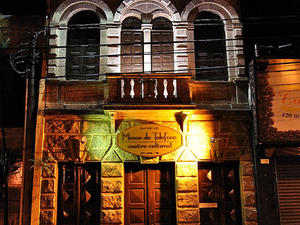 Telefone Museum - MAP 3 The Memory Center is the area of Telefonica Telefonica Foundation contributes to the formation of cultural identity, mainly of children and young people belonging to disadvantaged social groups in the country.
Through exhibitions, virtual galleries, research material and entertainment, the Telefonica Foundation provides for public consultation around 125-year history of telecommunications in Brazil.
Altogether there are thre... Telefone Museum - MAP 3 The Memory Center is the area of Telefonica Telefonica Foundation contributes to the formation of cultural identity, mainly of children and young people belonging to disadvantaged social groups in the country.
Through exhibitions, virtual galleries, research material and entertainment, the Telefonica Foundation provides for public consultation around 125-year history of telecommunications in Brazil.
Altogether there are thre... |
| Transportes Publicos Gaetano Cerolla Museum - MAP Museu dos Transportes Publicos Gaetano Cerolla
Avenida Cruzeiro do Sul 780
Bairro Caninde
Tel 3227-5860 |
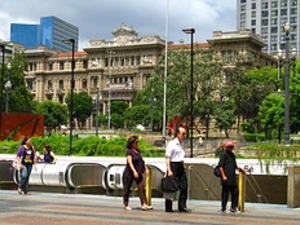 Tribunal de Justica do Estado de Sao Paulo Museum - MAP 3 In order to preserve the material elements pertaining to life and traditions of the Court of Justice, Des. Tácito Morbach de Góes Nobre established a Standing Committee to collect those elements of a historical nature, basis for the future Museum of the Court, consisting of four judges, under the chairmanship of the head of the judiciary. In 1994, the President of the Court, Judge José Alberto Weiss de Andrade establishes the Minimus... Tribunal de Justica do Estado de Sao Paulo Museum - MAP 3 In order to preserve the material elements pertaining to life and traditions of the Court of Justice, Des. Tácito Morbach de Góes Nobre established a Standing Committee to collect those elements of a historical nature, basis for the future Museum of the Court, consisting of four judges, under the chairmanship of the head of the judiciary. In 1994, the President of the Court, Judge José Alberto Weiss de Andrade establishes the Minimus... |
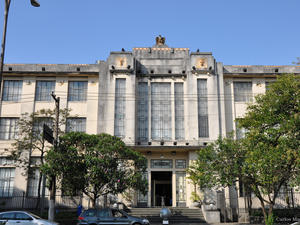 Zoologia da USP Museum - MAP 3
The Zoology Museum is housed in a building of architectural and historical interest, designed by architect Christiano Stockler das Neves and opened in 1941.
It was the first building in São Paulo built specifically as a museum.
Christiano Neves was also the author of the project Julio Prestes Station (now sharing space with the Sala São Paulo), at the same time.
The objectives of the Museum of Zoology are:
Keep... Zoologia da USP Museum - MAP 3
The Zoology Museum is housed in a building of architectural and historical interest, designed by architect Christiano Stockler das Neves and opened in 1941.
It was the first building in São Paulo built specifically as a museum.
Christiano Neves was also the author of the project Julio Prestes Station (now sharing space with the Sala São Paulo), at the same time.
The objectives of the Museum of Zoology are:
Keep... |
 Afro Brasileiro Museum - MAP 3
The Museu Afro Brazil is a public institution, subordinated to the Ministry of Culture of São Paulo Association and administered by the Museu Afro Brazil - Social Organization of Culture.
The Museum maintains a collection of more than 5,000 works, including paintings, sculptures, prints, photographs, documents and ethnological of Brazilian and foreign authors, produced between the fifteenth century...
Afro Brasileiro Museum - MAP 3
The Museu Afro Brazil is a public institution, subordinated to the Ministry of Culture of São Paulo Association and administered by the Museu Afro Brazil - Social Organization of Culture.
The Museum maintains a collection of more than 5,000 works, including paintings, sculptures, prints, photographs, documents and ethnological of Brazilian and foreign authors, produced between the fifteenth century... Arquivo do Estado - MAP 3
In the district of Santana are stored relics that tell the history of São Paulo. The Public Archives of the State of São Paulo is one of the oldest institutions of São Paulo. There you can find documents related to the basements of the military dictatorship, which belonged to the former state Department of Social Policy Order (DEOPS) and private collections of former governors and presidents, such as Julio Pre...
Arquivo do Estado - MAP 3
In the district of Santana are stored relics that tell the history of São Paulo. The Public Archives of the State of São Paulo is one of the oldest institutions of São Paulo. There you can find documents related to the basements of the military dictatorship, which belonged to the former state Department of Social Policy Order (DEOPS) and private collections of former governors and presidents, such as Julio Pre... Arte do Futebol Museum - MAP 6
The Museu da Arte do Futebol (Soccer Museum) location could not be more appropriate: it is under the stands at Pacaembu Stadium, the most beautiful of the city. To tell the history of Brazilian football, the curators turned to interactive audiovisual resources to the detriment of relics and collectibles.
At the entrance, pictures of stars like Pele, Zico and Ronaldo are projected on large screens hung from ...
Arte do Futebol Museum - MAP 6
The Museu da Arte do Futebol (Soccer Museum) location could not be more appropriate: it is under the stands at Pacaembu Stadium, the most beautiful of the city. To tell the history of Brazilian football, the curators turned to interactive audiovisual resources to the detriment of relics and collectibles.
At the entrance, pictures of stars like Pele, Zico and Ronaldo are projected on large screens hung from ... Arte Moderna de Sao Paulo Museum - MAP 3 The Museum of Modern Art of São Paulo MAM is a public interest civil society, non-profit, and is one of the most important museums in Latin America.
They are part of his collection more than 5000 works, bringing together over one thousand artists among the most expressive of modern and contemporary art in Brazil.
The MAM maintains an annual schedule of major exhibitions and promotes every two years, the panorama of Brazilian art, one...
Arte Moderna de Sao Paulo Museum - MAP 3 The Museum of Modern Art of São Paulo MAM is a public interest civil society, non-profit, and is one of the most important museums in Latin America.
They are part of his collection more than 5000 works, bringing together over one thousand artists among the most expressive of modern and contemporary art in Brazil.
The MAM maintains an annual schedule of major exhibitions and promotes every two years, the panorama of Brazilian art, one... Arte Sacra de São Paulo Museum - MAP (Art Sacred Museum of São Paulo)The Museum of Sacred Art of Sao Paulo works in what was once a monastery, The Monastery of Light, which was founded and built by Friar Antonio de Sant'Anna Galvao, in 1774 and is currently considered one of the most important architectural monuments colonial eighteenth-century Sao Paulo. Closed on the last farm urban convent in light district, the heart of the city of Sao Paulo, was listed by the Nationa...
Arte Sacra de São Paulo Museum - MAP (Art Sacred Museum of São Paulo)The Museum of Sacred Art of Sao Paulo works in what was once a monastery, The Monastery of Light, which was founded and built by Friar Antonio de Sant'Anna Galvao, in 1774 and is currently considered one of the most important architectural monuments colonial eighteenth-century Sao Paulo. Closed on the last farm urban convent in light district, the heart of the city of Sao Paulo, was listed by the Nationa... Brasileiro de Escultura Museum - MAP 3
The MuBE - Brazilian Sculpture Museum is a private institution of public interest, created to promote art in its various segments, sculpture, painting, photography, graffiti, drawing, music, cinema. Located in Sao Paulo, home to an extensive schedule, with special attention to the sculptural production in Brazil.
The museum receives annually from 80 to 100 thousand people to see its collection, visit its exhibitions, p...
Brasileiro de Escultura Museum - MAP 3
The MuBE - Brazilian Sculpture Museum is a private institution of public interest, created to promote art in its various segments, sculpture, painting, photography, graffiti, drawing, music, cinema. Located in Sao Paulo, home to an extensive schedule, with special attention to the sculptural production in Brazil.
The museum receives annually from 80 to 100 thousand people to see its collection, visit its exhibitions, p... Caixa Economica Federal Museum - MAP
Who passes through Cathedral Square always has an eye toward an imposing building whose facade boasts black granite Ionic colonnade surmounted by imposing too sober and classic pediment. The building is where the agency operates the Federal Savings Bank.
For a long time the place was the seat of the presidency of the box. With unification in 1971, it housed the headquarters of the São Paulo branch, until in 1979...
Caixa Economica Federal Museum - MAP
Who passes through Cathedral Square always has an eye toward an imposing building whose facade boasts black granite Ionic colonnade surmounted by imposing too sober and classic pediment. The building is where the agency operates the Federal Savings Bank.
For a long time the place was the seat of the presidency of the box. With unification in 1971, it housed the headquarters of the São Paulo branch, until in 1979... Casa Brasileira Museum - MAP Created in May 1970 under the name Museum of Art and Furniture History of Brazil, in1971 changed its name to the Brazilian House. Its main objective is the formation of aresearch center on equipment and customs of Brazilian houses, with permanent exhibition of its collection.
The Brazilian House Museum (MCB), a prime location for easy access in the city of São Paulo (Avenida Brigadeiro Faria Lima, 2705), seeks to fulfill this task. ...
Casa Brasileira Museum - MAP Created in May 1970 under the name Museum of Art and Furniture History of Brazil, in1971 changed its name to the Brazilian House. Its main objective is the formation of aresearch center on equipment and customs of Brazilian houses, with permanent exhibition of its collection.
The Brazilian House Museum (MCB), a prime location for easy access in the city of São Paulo (Avenida Brigadeiro Faria Lima, 2705), seeks to fulfill this task. ... Casa do Grito - MAP 3
The Museum of the City of São Paulo is organized through a network of twelve historic buildings and areas administered by the Department of Historic (DPH).
Created in 1993, its conceptualization and implementation have been made gradually over successive governments. The conceptual and administrative core of the network lies in the combination of the Solar da Marquesa de Santos, Pinto Alley (...
Casa do Grito - MAP 3
The Museum of the City of São Paulo is organized through a network of twelve historic buildings and areas administered by the Department of Historic (DPH).
Created in 1993, its conceptualization and implementation have been made gradually over successive governments. The conceptual and administrative core of the network lies in the combination of the Solar da Marquesa de Santos, Pinto Alley (... Casa Guilherme de Almeida - MAP 3
Opened in March 1979, houses a significant collection consisting of objects that belonged to the poet, translator, journalist and lawyer Paulo Guilherme de Almeida (1890-1969), one of the masterminds of the Brazilian modernist movement.
The museum is housed in the residence where he lived from 1946 until the year of his death. The House of Paulo Guilherme de Almeida - whose main objective is to promote knowledge of the...
Casa Guilherme de Almeida - MAP 3
Opened in March 1979, houses a significant collection consisting of objects that belonged to the poet, translator, journalist and lawyer Paulo Guilherme de Almeida (1890-1969), one of the masterminds of the Brazilian modernist movement.
The museum is housed in the residence where he lived from 1946 until the year of his death. The House of Paulo Guilherme de Almeida - whose main objective is to promote knowledge of the... Centro Cultural Sao Paulo - MAP 3
Initially designed to house an extension of Mário de Andrade Library, Centro Cultural São Paulo suffered in the course of its construction, a series of changes to become one of the first multidisciplinary cultural venues in the country.
Opened in 1982, offers theater, dance and music, visual arts exhibitions, film and video projections, workshops, debates and courses, and maintains significant collections...
Centro Cultural Sao Paulo - MAP 3
Initially designed to house an extension of Mário de Andrade Library, Centro Cultural São Paulo suffered in the course of its construction, a series of changes to become one of the first multidisciplinary cultural venues in the country.
Opened in 1982, offers theater, dance and music, visual arts exhibitions, film and video projections, workshops, debates and courses, and maintains significant collections... Cinemateca Brasileira - MAP 3
The Brazilian Cinema emerged from the creation of the Film Club of São Paulo in 1940. Its founders were young students of the Philosophy of the USP, including, Paulo Emilio Salles Gomes, Decio de Almeida Prado and Antonio Candido de Mello e Souza. The Club was closed by the police during the Estado Novo.
Its historic buildings, opened in the nineteenth century, were listed by Condephaat - Council of Defens...
Cinemateca Brasileira - MAP 3
The Brazilian Cinema emerged from the creation of the Film Club of São Paulo in 1940. Its founders were young students of the Philosophy of the USP, including, Paulo Emilio Salles Gomes, Decio de Almeida Prado and Antonio Candido de Mello e Souza. The Club was closed by the police during the Estado Novo.
Its historic buildings, opened in the nineteenth century, were listed by Condephaat - Council of Defens... Computador Museum - MAP 3
The Computer Museum is more than 12 years making the preservation of the history of the world's computers.
The collection includes over 10,000 pieces ranging from abacus to the modern computers. Behind every piece there is a history and you will find beyond the history of each machine also its inventors who made history with his inventions.
Address: Avenida Rio Bonito 1201
Bairro do Socorro
...
Computador Museum - MAP 3
The Computer Museum is more than 12 years making the preservation of the history of the world's computers.
The collection includes over 10,000 pieces ranging from abacus to the modern computers. Behind every piece there is a history and you will find beyond the history of each machine also its inventors who made history with his inventions.
Address: Avenida Rio Bonito 1201
Bairro do Socorro
... Instituto Biologico Museum - MAP 3
The collection of the Biological Institute began in 1927. Initially, the scientific activities of the institution were held in rented houses and Arthur Neiva, the first director, housed a library in a location at Luis Antonio Ave. that, in addition to magazines and books on coffee pests, the creation of the IB paradigm, other books and texts were being added.
Henrique da Rocha Lima, José Reis and...
Instituto Biologico Museum - MAP 3
The collection of the Biological Institute began in 1927. Initially, the scientific activities of the institution were held in rented houses and Arthur Neiva, the first director, housed a library in a location at Luis Antonio Ave. that, in addition to magazines and books on coffee pests, the creation of the IB paradigm, other books and texts were being added.
Henrique da Rocha Lima, José Reis and... Lingua Portuguesa Museum - MAP 6
The Portuguese Language Museum is the meeting point with the visitor's language, literature and history displayed through visual aids and technology. Instead of walls, voices. In place of works, interactive spaces. In the heart of São Paulo in the Light Station, the Museum provides a sensory journey through the Portuguese language and subjective, the sixth most spoken language in the world, guided by words, writers and sta...
Lingua Portuguesa Museum - MAP 6
The Portuguese Language Museum is the meeting point with the visitor's language, literature and history displayed through visual aids and technology. Instead of walls, voices. In place of works, interactive spaces. In the heart of São Paulo in the Light Station, the Museum provides a sensory journey through the Portuguese language and subjective, the sixth most spoken language in the world, guided by words, writers and sta... Mam - Museu de Arte Moderna de São Paulo - MAP 3
The Museum of Modern Art in São Paulo - MAM is a public interest civil society, non-profit, and is one of the most important museums in Latin America. Its misson is to collect, study, promote and disseminate modern and contemporary art in Brazil, making it accessible to as many people as possible.
Part of its collection over 5000 works, bringing together more than a thousand artists among the most expressi...
Mam - Museu de Arte Moderna de São Paulo - MAP 3
The Museum of Modern Art in São Paulo - MAM is a public interest civil society, non-profit, and is one of the most important museums in Latin America. Its misson is to collect, study, promote and disseminate modern and contemporary art in Brazil, making it accessible to as many people as possible.
Part of its collection over 5000 works, bringing together more than a thousand artists among the most expressi... MASP - Museu de Arte de São Paulo - MAP MASP is the most important museum of western art in the Southern Hemisphere
Its collection is listed by the Historical and Artistic Heritage - IPHAN since 1969 and currently has about 8,000 pieces, among which stand out Western paintings, mainly Italian and French. Thirteenth century to today, you can enjoy Raphael, Mantegna and Botticceli - the Italian school - and Delacroix, Renoir, Monet, Cézanne, Picasso, Modigliani, Toulouse-L...
MASP - Museu de Arte de São Paulo - MAP MASP is the most important museum of western art in the Southern Hemisphere
Its collection is listed by the Historical and Artistic Heritage - IPHAN since 1969 and currently has about 8,000 pieces, among which stand out Western paintings, mainly Italian and French. Thirteenth century to today, you can enjoy Raphael, Mantegna and Botticceli - the Italian school - and Delacroix, Renoir, Monet, Cézanne, Picasso, Modigliani, Toulouse-L... Memorial da America Latina - MAP Memorial da America Latina
Avenida Auro Soares de Moura Andrade 664
Bairro da Barra Funda
Tel 3823-4600
http://www.memorial.sp.gov.br/memorial/index.jsp
Memorial da America Latina - MAP Memorial da America Latina
Avenida Auro Soares de Moura Andrade 664
Bairro da Barra Funda
Tel 3823-4600
http://www.memorial.sp.gov.br/memorial/index.jsp
 Memorial do Imigrante - MAP 6 Consolidated as a plural city, home to several nationalities, São Paulo has become, since 1870, the fate of many immigrants fleeing political and economic upheaval in their countries of origin - especially in Europe. The work on coffee farms has attracted many foreigners in search of a better life. To get them opened in the late nineteenth century, an inn in the neighborhood of Brás. The immigrants landed at the port of Santos and wer...
Memorial do Imigrante - MAP 6 Consolidated as a plural city, home to several nationalities, São Paulo has become, since 1870, the fate of many immigrants fleeing political and economic upheaval in their countries of origin - especially in Europe. The work on coffee farms has attracted many foreigners in search of a better life. To get them opened in the late nineteenth century, an inn in the neighborhood of Brás. The immigrants landed at the port of Santos and wer... Padre Anchieta Museum - MAP 3
Made up from donations and the return of some of the objects that originally belonged to the Church and the Jesuit College, the current collection of the museum is almost entirely exposed, without compliance with the criteria essential to their real characterization and subsequent recovery. The recent lementação museum and museological project allowed the objects that constitute the acquis could be identified, sorted, o...
Padre Anchieta Museum - MAP 3
Made up from donations and the return of some of the objects that originally belonged to the Church and the Jesuit College, the current collection of the museum is almost entirely exposed, without compliance with the criteria essential to their real characterization and subsequent recovery. The recent lementação museum and museological project allowed the objects that constitute the acquis could be identified, sorted, o... Paulista Museum - MAP
Museu Paulista ( Museu do Ipiranga )
Parque da Independecia S/N
Bairro do Ipiranga
Tel 6165-8000
http://www.mp.usp.br/
Paulista Museum - MAP
Museu Paulista ( Museu do Ipiranga )
Parque da Independecia S/N
Bairro do Ipiranga
Tel 6165-8000
http://www.mp.usp.br/
 Pinacoteca do Estado - MAP 3
The Pinacoteca do Estado de Sao Paulo Museum of Art is the city's oldest and certainly one of the most important country. Born in the building originally built to house the School of Arts and Crafts in St. Paul. Therefore, the history of Pinacoteca confused in its infancy with the deployment of Lyceum, and their presence in the building - troubled by a series of historical events, such as conflicts of 1930 and 1932, and refo...
Pinacoteca do Estado - MAP 3
The Pinacoteca do Estado de Sao Paulo Museum of Art is the city's oldest and certainly one of the most important country. Born in the building originally built to house the School of Arts and Crafts in St. Paul. Therefore, the history of Pinacoteca confused in its infancy with the deployment of Lyceum, and their presence in the building - troubled by a series of historical events, such as conflicts of 1930 and 1932, and refo... Pinacoteca do Estado de São Paulo - MAP The Pinacoteca do Estado de Sao Paulo art museum is the city's oldest and certainly one of the most important country. Born in the building originally built to house the School of Arts and Crafts in St. Paul. Therefore, the history of Pinacoteca confused in its infancy with the deployment of Lyceum, and his presence in the building - troubled by a series of historical events, such as conflicts of 1930 and 1932, and reforms - alternated ...
Pinacoteca do Estado de São Paulo - MAP The Pinacoteca do Estado de Sao Paulo art museum is the city's oldest and certainly one of the most important country. Born in the building originally built to house the School of Arts and Crafts in St. Paul. Therefore, the history of Pinacoteca confused in its infancy with the deployment of Lyceum, and his presence in the building - troubled by a series of historical events, such as conflicts of 1930 and 1932, and reforms - alternated ... Teatro Municipal de Sao Paulo Museum - MAP 3
Inaugurated on October 11, 1983, the Museum of the Municipal Theater of São Paulo intended to collect and preserve objects, documents, records and reports pertaining to the history of the theater.
The Museum keeps the history of the artistic and social Theater, part of it presented in a long-term exposure, are also organized exhibitions on themes related to architecture, shows and information shows of short dura...
Teatro Municipal de Sao Paulo Museum - MAP 3
Inaugurated on October 11, 1983, the Museum of the Municipal Theater of São Paulo intended to collect and preserve objects, documents, records and reports pertaining to the history of the theater.
The Museum keeps the history of the artistic and social Theater, part of it presented in a long-term exposure, are also organized exhibitions on themes related to architecture, shows and information shows of short dura... Telefone Museum - MAP 3 The Memory Center is the area of Telefonica Telefonica Foundation contributes to the formation of cultural identity, mainly of children and young people belonging to disadvantaged social groups in the country.
Through exhibitions, virtual galleries, research material and entertainment, the Telefonica Foundation provides for public consultation around 125-year history of telecommunications in Brazil.
Altogether there are thre...
Telefone Museum - MAP 3 The Memory Center is the area of Telefonica Telefonica Foundation contributes to the formation of cultural identity, mainly of children and young people belonging to disadvantaged social groups in the country.
Through exhibitions, virtual galleries, research material and entertainment, the Telefonica Foundation provides for public consultation around 125-year history of telecommunications in Brazil.
Altogether there are thre... Tribunal de Justica do Estado de Sao Paulo Museum - MAP 3 In order to preserve the material elements pertaining to life and traditions of the Court of Justice, Des. Tácito Morbach de Góes Nobre established a Standing Committee to collect those elements of a historical nature, basis for the future Museum of the Court, consisting of four judges, under the chairmanship of the head of the judiciary. In 1994, the President of the Court, Judge José Alberto Weiss de Andrade establishes the Minimus...
Tribunal de Justica do Estado de Sao Paulo Museum - MAP 3 In order to preserve the material elements pertaining to life and traditions of the Court of Justice, Des. Tácito Morbach de Góes Nobre established a Standing Committee to collect those elements of a historical nature, basis for the future Museum of the Court, consisting of four judges, under the chairmanship of the head of the judiciary. In 1994, the President of the Court, Judge José Alberto Weiss de Andrade establishes the Minimus... Zoologia da USP Museum - MAP 3
The Zoology Museum is housed in a building of architectural and historical interest, designed by architect Christiano Stockler das Neves and opened in 1941.
It was the first building in São Paulo built specifically as a museum.
Christiano Neves was also the author of the project Julio Prestes Station (now sharing space with the Sala São Paulo), at the same time.
The objectives of the Museum of Zoology are:
Keep...
Zoologia da USP Museum - MAP 3
The Zoology Museum is housed in a building of architectural and historical interest, designed by architect Christiano Stockler das Neves and opened in 1941.
It was the first building in São Paulo built specifically as a museum.
Christiano Neves was also the author of the project Julio Prestes Station (now sharing space with the Sala São Paulo), at the same time.
The objectives of the Museum of Zoology are:
Keep...